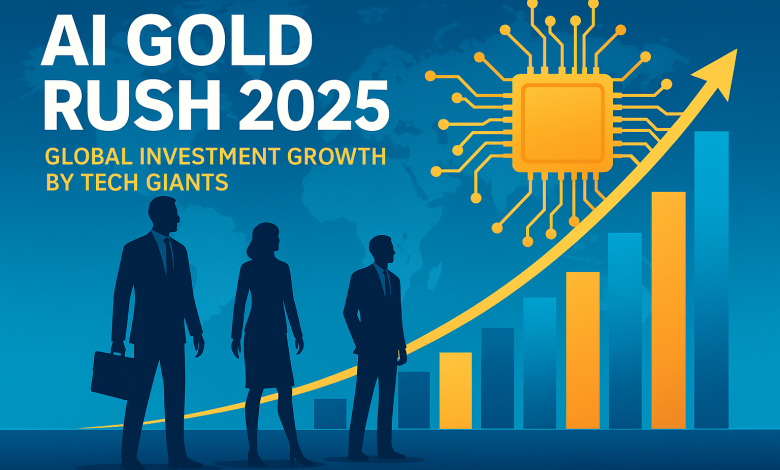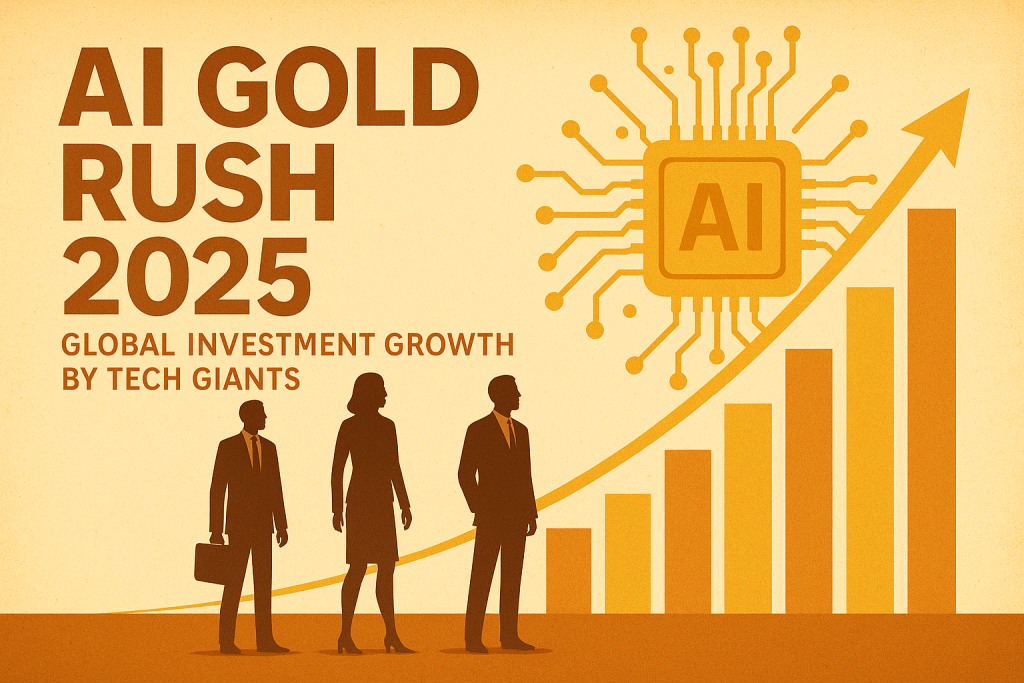The AI Gold Rush 2025: Tech Giants Ignite a Market Boom with Massive AI Investments
The year 2025 marks an inflection point in the global economy as artificial intelligence (AI) becomes the centerpiece of technology investment and innovation. With Amazon and Meta leading multi-billion-dollar initiatives, markets are witnessing an unprecedented surge in tech-driven growth. This “AI Gold Rush” is redefining the Nasdaq, propelling the S&P 500, and signaling a new industrial revolution driven by automation and advanced computing.

Key Developments
Amazon and Meta have made record-breaking commitments to AI infrastructure in 2025, underscoring the sector’s strategic importance.

Amazon’s $100 Billion AI Ambition
Amazon is investing more than $100 billion in capital expenditures, focusing heavily on Amazon Web Services (AWS) and custom AI chip development. CEO Andy Jassy has called generative AI a “once-in-a-lifetime opportunity.” AWS’s AI division already delivers multi-billion-dollar annual revenue, driven by triple-digit growth. Key initiatives include:
-
Expanding its $8 billion investment in Anthropic, a leading AI model developer.
-
Supporting Scale AI for data labeling and model training.
-
Scaling internal AI usage for logistics, robotics, and forecasting.
-
Developing Graviton, Trainium, and Inferentia chips via Annapurna Labs.
Meta’s $65 Billion AI Infrastructure Push
Meta is ramping up capital spending to $60–$65 billion in 2025, up from $40 billion in 2024. CEO Mark Zuckerberg’s strategy centers on becoming a global AI leader through:
-
Building massive data centers with over 2 gigawatts of capacity.
-
Acquiring 1.3 million GPUs and achieving 1 gigawatt of compute power.
-
Expanding open-source Llama models and integrating Meta AI across Facebook, Instagram, and WhatsApp (expected to reach 1 billion users).
-
Exploring a $10 billion investment in Scale AI and developing AI-powered Ray-Ban smart glasses.
Together, these initiatives have positioned AI as the backbone of global technology infrastructure and a key catalyst for market expansion.
Market Impact
The combined AI spending by Amazon, Meta, and other giants has triggered a massive ripple effect across global markets.
Winners:
-
Semiconductors: NVIDIA, AMD, Intel, and TSMC dominate with record GPU and chip demand.
-
Memory & Infrastructure: Samsung, Micron, and SK Hynix benefit from high-bandwidth memory sales.
-
Utilities & Energy: Global electricity demand surges, driving capital expenditures up 22% YoY to $212 billion.
-
Data Centers: Explosive growth in cooling, power systems, and networking equipment.
Losers:
-
Traditional software firms lacking AI offerings risk market erosion.
-
Staffing agencies dependent on manual labor face reduced contracts due to automation.
-
Smaller AI startups may struggle as Meta shifts toward proprietary models.
This dynamic mirrors the early internet era—creating massive growth for innovators while intensifying challenges for laggards.
Expert Insights
Industry analysts describe 2025 as “the AI arms race decade.”
According to TechMarket Intelligence, AI spending by major U.S. and global firms could reach $320 billion this year — up from $230 billion in 2024.
Experts emphasize:
-
AI is reshaping labor markets, with Amazon cutting 15% of its HR division and retraining employees in automation.
-
The EU AI Act (2025–2026) will enforce strict compliance for high-risk AI systems.
-
Over 70% of S&P 500 companies now disclose AI-related risks, compared to just 12% in 2023.
-
Regulators, including the IMF and Bank of England, warn of potential speculative bubbles similar to the dot-com era.
Yet many believe the fundamentals are stronger than in the 1990s, supported by diversified revenue streams and real-world AI adoption.
Future Outlook
The next five years are expected to define the structure of the AI-driven global economy.
Short-term (2025–2026):
-
Rapid rollout of agentic AI capable of multi-step task automation.
-
Expansion of AIaaS (AI-as-a-Service) offerings.
-
Continued growth in enterprise AI integration and cloud computing.
Long-term (2027–2030):
-
The global AI market could surpass $1 trillion, with potential progress toward Artificial General Intelligence (AGI).
-
The AI governance industry may reach $1.4 billion by 2030.
-
Hybrid AI architectures will merge centralized training with decentralized inference.
However, key challenges persist:
-
Soaring energy and water consumption in AI data centers.
-
Persistent talent shortages in machine learning.
-
Regulatory tightening and market volatility amid stretched valuations.
FAQs
1. What is driving the 2025 AI investment boom?
Massive capital allocations by tech giants seeking dominance in AI infrastructure and generative model innovation.
2. How much is Amazon investing in AI?
Over $100 billion in 2025, mostly within AWS for AI infrastructure and custom chip design.
3. What makes Meta’s AI strategy unique?
Its open-source Llama models and deep integration of AI assistants across all platforms.
4. Are AI investments sustainable long-term?
Analysts suggest long-term viability depends on measurable ROI, efficient energy use, and regulatory adaptation.
5. Could there be an AI bubble?
Some experts warn of overvaluation similar to the late-1990s tech boom, though current fundamentals remain stronger.
6. Which sectors will benefit most?
Semiconductors, energy, cloud infrastructure, and AI governance are expected to see sustained growth.
Key Takeaways
-
Amazon and Meta are investing over $160 billion combined in AI infrastructure in 2025.
-
Semiconductor, cloud, and data center industries are primary beneficiaries.
-
Regulatory oversight is tightening as AI becomes a systemic economic force.
-
AI is reshaping the global workforce through automation and reskilling.
-
Market growth remains strong but increasingly sensitive to valuation and regulation.
Stay informed: Follow Industry News 2025 for the latest updates on AI investments, mergers, and the evolving global technology landscape.
